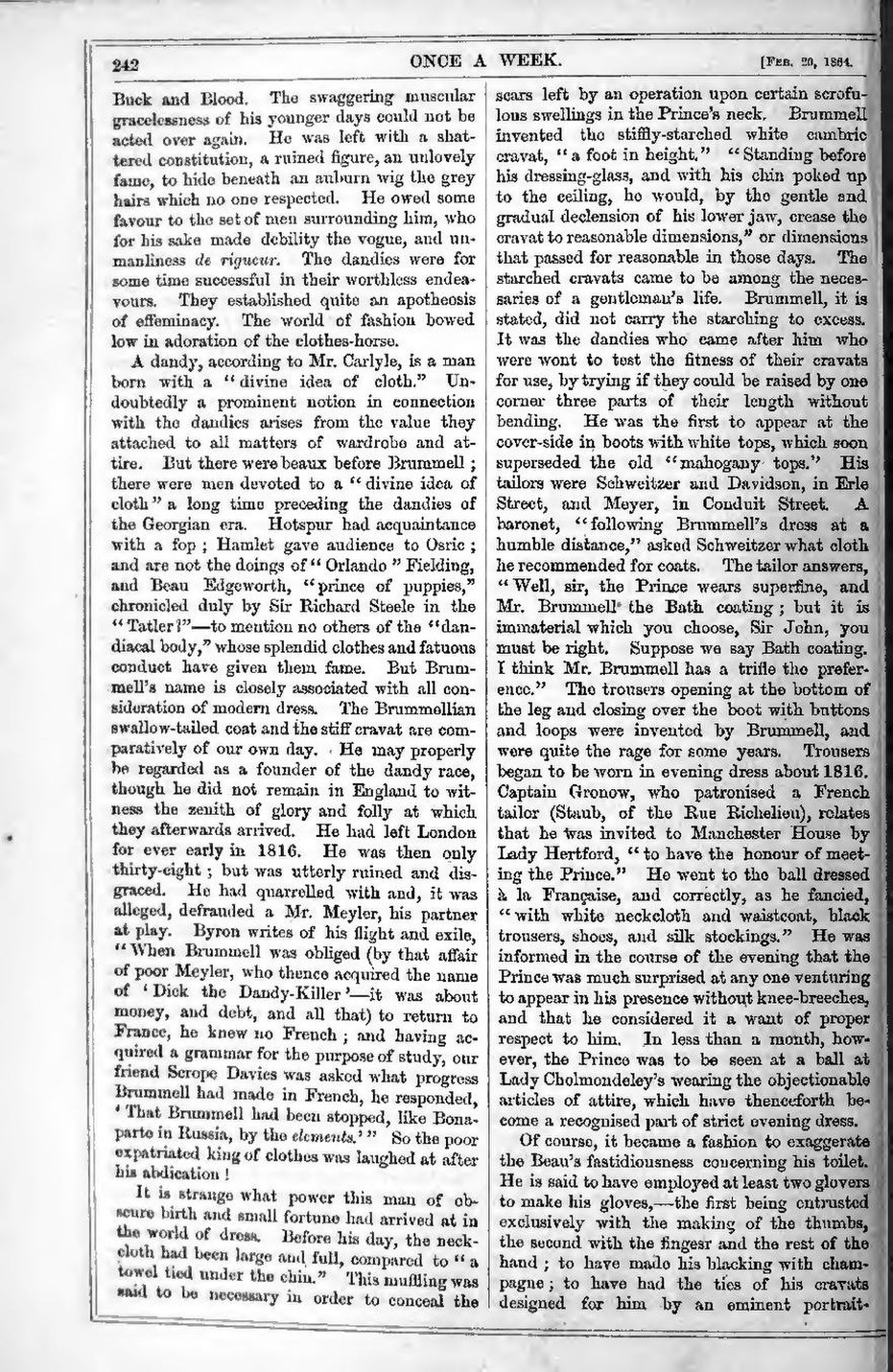242 Buck and Blood. The swaggering muscular gracelessness of his younger days could not be acted over again. He was left with a shat- tered constitution, a ruined figure, an unlovely fame, to hide beneath an auburn wig the grey hairs which no one respected. He owed some favour to the set of men surrounding him, who for his sake made debility the vogue, and un- manliness de rigueur. The dandies were for some time successful in their worthless endea vours. They established quite an apotheosis of effeminacy. The world of fashion bowed low in adoration of the clothes-horse. ONCE A WEEK. A dandy, according to Mr. Carlyle, is a man born with a "divine idea of cloth." Un- doubtedly a prominent notion in connection with the dandies arises from the value they attached to all matters of wardrobe and at- tire. But there were beaux before Brummell; there were men devoted to a "divine idea of cloth" a long time preceding the dandies of the Georgian era. Hotspur had acquaintance with a fop; Hamlet gave audience to Osric; and are not the doings of "Orlando " Fielding, and Beau Edgeworth, "prince of puppies," chronicled duly by Sir Richard Steele in the
- Tatler ?"-to mention no others of the "dan-
diacal body," whose splendid clothes and fatuons conduct have given them fame. But Brum- mell's name is closely associated with all con- siduration of modern dress. The Brummellian swallow-tailed coat and the stiff cravat are com- paratively of our own day. He may properly be regarded as a founder of the dandy race, though he did not remain in England to wit- ness the zenith of glory and folly at which they afterwards arrived. He had left London < for ever early in 1816. He was then only thirty-eight; but was utterly ruined and dis- graced. He had quarrelled with and, it was alleged, defrauded a Mr. Meyler, his partner at play. Byron writes of his flight and exile, "When Brummell was obliged (by that affair of poor Meyler, who thence acquired the name of Dick the Dandy-Killer'-it was about money, and debt, and all that) to return to France, he knew no French; and having ac- quired a grammar for the purpose of study, our friend Scrope Davies was asked what progress Brummell had made in French, he responded,
- That Brummell had been stopped, like Bona-
parto in Russia, by the elements."" So the poor expatriated king of clothes was laughed at after his abdication ! It is strange what power this man of ob scure birth and small fortune had arrived at in the world of dress. Before his day, the neck- cloth had been large and full, compared to " towel tied under the chin." This muftling was said to be necessary in order to conceal the a [FEB. 20, 1884. scars left by an operation upon certain scrofu- lous swellings in the Prince's neck, Brummell invented the stiffy-starched white cambric cravat, "a foot in height." "Standing before his dressing-glass, and with his chin poked up to the ceiling, he would, by the gentle and gradual declension of his lower jaw, crease the cravat to reasonable dimensions," or dimensions that passed for reasonable in those days. The starched cravats came to be among the neces- saries of a gentlemau's life. Brummell, it is stated, did not carry the starching to excess. It was the dandies who came after him who were wont to test the fitness of their cravats for use, by trying if they could be raised by one corner three parts of their length without bending. He was the first to appear at the cover-side in boots with white tops, which soon superseded the old "mahogany tops." His tailors were Schweitzer and Davidson, in Erle Street, and Meyer, in Conduit Street. baronet, "following Brummell's dress at a humble distance," asked Schweitzer what cloth he recommended for coats. The tailor answers, "Well, sir, the Prince wears superfine, and Mr. Brummell the Bath coating; but it is immaterial which you choose, Sir John, you must be right. Suppose we say Bath coating. I think Mr. Brummell has a trifle the prefer- ence." "" The trousers opening at the bottom of the leg and closing over the boot with buttons and loops were invented by Brummell, and were quite the rage for some years. Trousers began to be worn in evening dress about 1816. Captain Gronow, who patronised a French tailor (Staub, of the Rue Richelieu), relates that he was invited to Manchester House by Lady Hertford, "to have the honour of meet- ing the Prince." He went to the ball dressed à la Française, and correctly, as he fancied, with white neckcloth and waistcont, black trousers, shoes, and silk stockings." He was informed in the course of the evening that the Prince was much surprised at any one venturing to appear in his presence without knee-breeches, and that he considered it a want of proper dit a respect to him. In less than a month, how- ever, the Prince was to be seen at a ball at Lady Cholmondeley's wearing the objectionable articles of attire, which have thenceforth be- come a recognised part of strict evening dress. Of course, it became a fashion to exaggerate the Beau's fastidiousness concerning his toilet. He is said to have employed at least two glovers to make his gloves, the first being cntrusted exclusively with the making of the thumbs, the second with the fingesr and the rest of the hand; to have made his blacking with cham- pagne; to have had the ties of his cravats
designed for him by an eminent portrait-